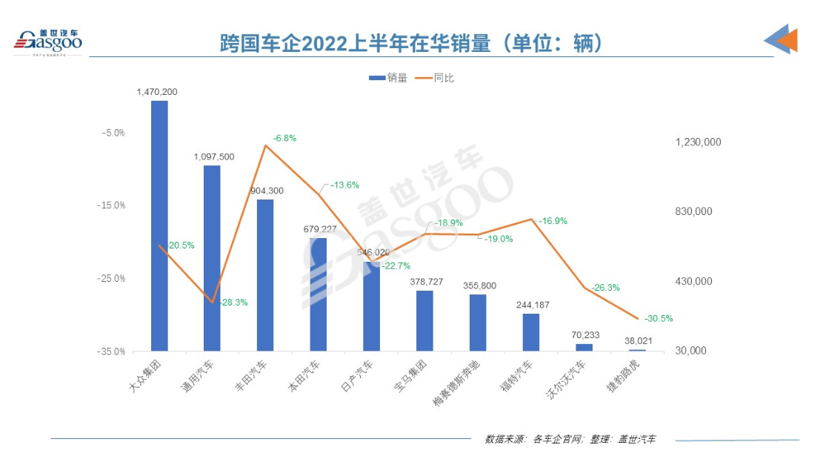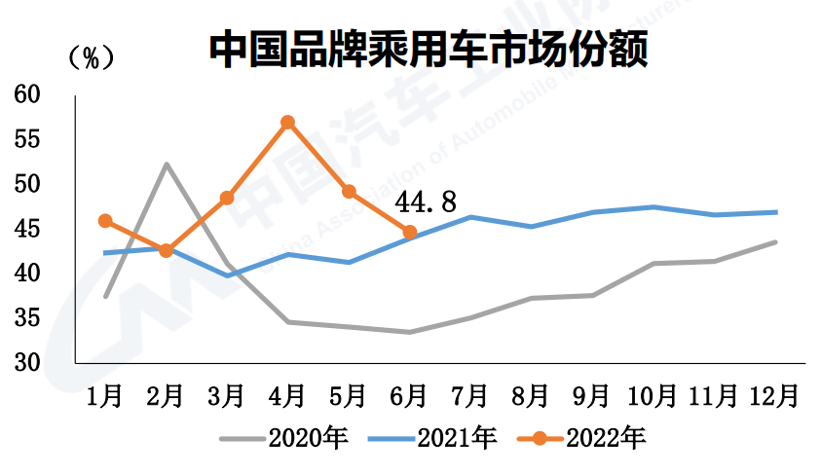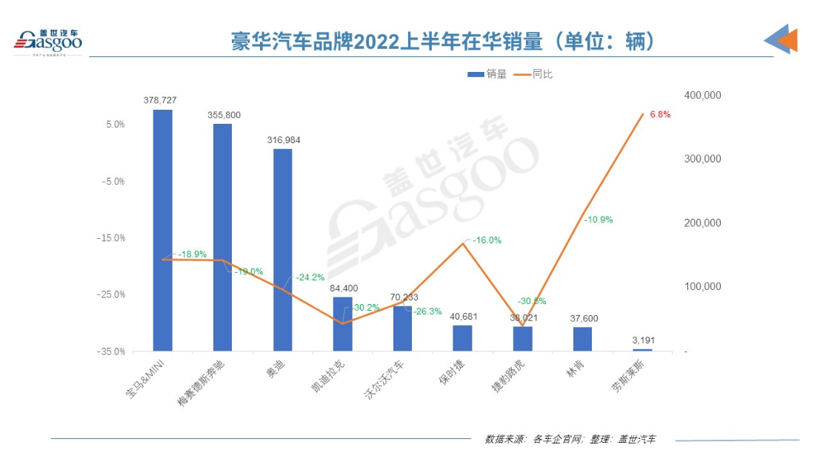According to the data of the China Automobile Association, in the first half of this year, due to the multiple outbreaks of domestic epidemics and the continuous shortage of chips, the production and sales of automobiles in the Chinese market reached 12.117 million and 12.057 million respectively, a year-on-year decrease of 3.7% and 6.6% respectively.In this context, the sales of multinational car companies in China also fell invariably, and most of them showed double-digit declines.
access:
Alibaba Cloud’s “Shadowless Cloud Computer” supports enterprises to quickly realize home office

The overall share of multinational car companies in China has declined, and Volkswagen is still the sales leader
According to the official data released by various car companies, Gasgoo has sorted out the sales of 10 multinational car companies in the Chinese market in the first half of the year, of which only Toyota’s sales fell by less than 10%. In terms of specific sales, Volkswagen Group is still the sales champion in the Chinese market, with a total of 1.47 million units sold; General Motors followed closely with sales of nearly 1.1 million units; except for these two car companies, other car companies sold in China. No more than one million vehicles.
The top three Japanese companies (Toyota, Honda and Nissan) still occupy the last three seats in the top five, with Nissan taking the biggest drop. Nissan China also includes commercial vehicles in sales statistics. In the first half of the year, the cumulative sales in China fell by 22.7% year-on-year, mainly due to the sluggish performance of the commercial vehicle segment. From January to June, the cumulative sales of Nissan’s commercial vehicles was 97,214 units, a year-on-year decrease. 25.6%.
Among Honda’s sales results, the sharp and hybrid models contributed more, with sales of 100,022 units in the first half of the year. The hot sale of hybrid models is due to a certain extent due to the continued rise in oil prices, and fuel-efficient models are popular. Toyota is still the best Japanese car company in China. Both Toyota’s joint ventures in China have handed over a dazzling report card. Even though the overall auto market was under pressure in the first half of the year, Toyota still showed strong brand competition. force.

(Image source: China Automobile Association)
But overall, the overall share of multinational automakers in China is still declining. According to data from the China Automobile Association, in the first half of the year, Chinese brand passenger vehicles sold a total of 4.891 million units, a year-on-year increase of 16.5%, accounting for 47.2% of the total passenger vehicle sales, an increase of 5.3 percentage points from the same period last year. In contrast, the market shares of German and Japanese brands, which previously occupied a considerable share in China, have both declined, highlighting the gradual rise of Chinese brands.
In the field of new energy vehicles, Chinese brands have become the absolute main force. By accelerating the integration with intelligent network connection, Chinese brand passenger car companies have also taken the lead, and even surpassed joint venture brands in some technical fields. In addition, with a precise grasp of China’s auto consumption market, Chinese brands are also favored by more young consumers. In addition, relying on the advantages of local supply chains, Chinese brands have seized more opportunities.
Foreign luxury brands also failed to withstand the downward headwind

In recent years, with the continuous improvement of the income level of Chinese residents, China’s auto market has shown a clear trend of consumption upgrading. Therefore, the luxury car segment can be said to be advancing all the way, and it can withstand headwinds better than the overall auto market. However, in the first half of this year, due to the impact of the epidemic, the pace of increase and replacement has slowed down, the terminal market was inactive, and the sales volume of the luxury car market dropped slightly by 1.3% year-on-year. Among the nine luxury brands counted by Gasgoo, most of them experienced double-digit sales declines in China in the first half of the year, significantly higher than the overall market.
As the leaders of the luxury car market, BMW and Mercedes-Benz sales in China fell by 18.9% and 19.4% year-on-year respectively in the first half of the year. However, BMW continued to maintain its leading position in China’s luxury car market, widening the gap with Mercedes-Benz to 22,900 units, compared with more than 7,000 units in the first quarter. Audi remains firmly in third place, also in the 300,000-car club.
As far as products are concerned, in the first half of this year, the popularity of the BMW 4 Series remains unabated, with sales increasing by 43.8% year-on-year. The BMW M brand continued to celebrate its 50th anniversary with sales up 37.6 percent year-on-year. Mercedes-Benz’s S-Class sedan continued to maintain its market leadership with a 13% year-on-year increase, while the high-end luxury brand Mercedes-Maybach’s market sales hit a new high for the same period, up 62% year-on-year.
The gap between the second-tier luxury brand camp led by Cadillac and BBA is still very large, and the sales volume of Cadillac has not even exceeded the threshold of 100,000 vehicles. However, Cadillac’s LYRIQ all-electric luxury SUV, which rolled off the assembly line in May and is now open for order, is expected to bring new growth drivers to the brand. Lincoln is the brand with the smallest sales decline among the second-tier camps. To a certain extent, thanks to the record performance in June, the Lincoln brand achieved the best performance in the same period in China last month, with sales increasing by 19% year-on-year and 70% month-on-month.
The Rolls-Royce brand was the only luxury brand in the table to record sales growth in China in the first half of the year, with the company revealing that demand for all of its models continued to be strong, with customer orders now extending to 2023. The company’s first pure electric vehicle, the Rolls-Royce Spectre, is currently undergoing extensive testing and is expected to go on sale in the fourth quarter of 2023.
In general, the decline in sales of foreign luxury brands in China in the first half of the year was due to the loss of production capacity due to the epidemic and lack of cores. Taking Xiaopeng and Li Auto as an example, in the first half of this year, the two car companies delivered more than 60,000 vehicles, more than doubling year-on-year.
New energy vehicle sales of multinational car companies are a bright spot
In the first half of the year, although the production and sales of new energy vehicles in China were also affected by the epidemic, as companies attached great importance to new energy vehicle products, the supply chain resources were prioritized to focus on new energy vehicles, and the overall production and sales completion exceeded expectations. According to the data of the China Automobile Association, the production and sales of new energy vehicles in the first half of the year were 2.661 million and 2.6 million, an increase of 1.2 times year-on-year, and the market share reached 21.6%, and the sales of new energy vehicles of multinational car companies also contributed to this. It has made a contribution and has become the “Pearl” in the crown of various car companies.
Although BMW’s overall sales in China in the first half of the year fell by 18.9% year-on-year, the sales of pure electric vehicles increased by 74.8% year-on-year. Volvo Cars’ sales in China in the first half of the year fell by 1.3% compared with the same period last year, but the sales of pure electric vehicles rose by 213% year-on-year. Mercedes-Benz’s new energy models also achieved good sales results and achieved substantial growth. Mercedes-EQ products achieved a quarter-on-quarter growth of 28% in the second quarter, among which the EQC pure electric SUV market performed steadily, and the new-generation luxury EQA SUV, EQB SUV and the large luxury electric benchmark EQS saw a steady increase in the market performance in the first sales year. Plug-in hybrid models continued their strong momentum.
In the first half of the year, the overall sales of pure electric vehicles of various brands of the Volkswagen Group surged by 247%. The Ford brand’s sales of electric vehicles in the second quarter exceeded 1,900 units. The delivery of the Mustang Mach-E still increased by 15.7% compared with the first quarter to 1,918 units, and a total of 3,576 units were delivered in the first half of the year. GM’s sales of new energy vehicles grew strongly in the second quarter, up 12.5% year-on-year.
Despite the strong performance of foreign brands of electric vehicles, they continue to be threatened by the rising rise of Chinese brands of new energy vehicles. In this context, multinational car companies continue to increase the weight of China’s new energy vehicle market and accelerate the electrification offensive.
For example, despite the challenges, BMW is still making great strides in promoting electrification and continuing to expand investment in the Chinese market. At the end of June, BMW’s electric vehicle production-oriented Lida plant officially opened. The new plant has a total investment of 15 billion yuan and can produce up to 100% of electric vehicles. The all-electric new BMW i3 is already in production here.
GM will implement an intensive launch plan for all its brands in China this year, bringing more than 20 new and updated models to the market, with a focus on new energy vehicles and the premium segment. Following the Cadillac LYRIQ, Buick and Chevrolet’s Ultium EVs will debut in China in the second half of this year. It is conceivable that the competition in China’s new energy vehicle market will become more and more intense in the future.